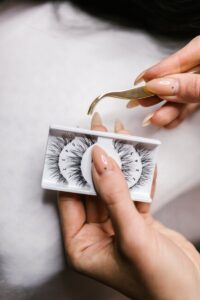Choose the Right Eyelash Adhesive: Your Guide to Lash Extension Glue
In the world of eyelash extensions, the choice of eyelash adhesive plays a crucial role in the overall outcome of the lash application. Selecting the right lash glue not only ensures the best retention but also impacts the comfort and satisfaction of clients. This guide will help you navigate through the various types of lash adhesives available and understand their specific uses.

Photo by Tommy van Kessel on Unsplash
Understanding Lash Adhesives
Eyelash adhesive is a specialized glue crafted specifically for attaching eyelash extensions to natural lashes. This adhesive is formulated to withstand the daily wear and tear, providing a long-lasting bond that enhances the beauty of the extensions. It is essential for lash artists to understand the properties of different adhesives to ensure a successful application and satisfied clients.
What is Eyelash Adhesive?
Eyelash adhesive, often referred to as lash glue, is designed to create a strong bond between the eyelash extensions and the natural lash line. The glue typically contains various ingredients that contribute to its viscosity, dry time, and retention capabilities. An experienced lash artist knows that the right eyelash extension adhesive can significantly affect the durability of the lash extensions and the comfort of the client during wear.
Types of Eyelash Extension Glue
There is a wide range of lash adhesives available, each tailored for specific conditions and client needs. For example, there are adhesives designed for high humidity environments, while others cater to sensitive eyes. Lash artists should carefully choose an adhesive that not only matches the client’s preferences but also suits their own skill level—whether they are a beginner or an advanced lash artist.
Importance of Choosing the Right Adhesive
Choosing the right eyelash adhesive is paramount in achieving the best retention and ensuring that the extensions stay put for weeks. The right glue will dry quickly, allowing lash artists to work efficiently, while also minimizing irritation from glue fumes. In contrast, using an inappropriate adhesive can lead to client dissatisfaction and compromised results. Therefore, understanding the specific needs and conditions of each client is essential for lash artists striving for excellence.

Photo by cottonbro studio on Pexels
Factors to Consider When Choosing Lash Extension Glue
Fume Levels and Sensitivity
When selecting lash extension adhesive, one of the most critical factors to consider is the fume levels of the glue. Some clients may have heightened sensitivity to adhesive fumes, which can lead to discomfort or allergic reactions. Therefore, lash artists should choose an adhesive that is low in fumes, particularly for clients with sensitive eyes. Understanding the sensitivity levels of each client will help ensure that the chosen lash glue is suitable for their unique needs, promoting a comfortable and enjoyable experience during and after the lash application process.
Drying Time and Lashing Speed
The drying time of the eyelash extension glue significantly influences the lashing speed and overall efficiency of the lash artist. A glue that dries too quickly may not allow enough time for precise application, while a longer drying time can hinder the overall lashing process. For beginners, it’s often recommended to start with a lash adhesive that has a moderate dry time, allowing ample opportunity to adjust and place each extension accurately. Experienced lash artists, on the other hand, may prefer faster-drying adhesives to maximize their lashing speed and enhance lash retention for their clients.
Ingredients and Allergens
Another vital aspect in choosing the right eyelash extension adhesive is the ingredients used in the formulation. Many lash adhesives contain cyanoacrylate, which provides a strong bond but may also be a potential allergen for some clients. Therefore, it is essential to review the ingredient list for any known allergens. Lash artists should proactively communicate with clients about their sensitivities and preferences, helping them select an adhesive that minimizes the risk of irritation while ensuring optimal retention and performance.

Photo by RDNE Stock project on Pexels
Choosing the Right Eyelash Extension Adhesive for Beginners
Best Practices for New Lash Artists
For beginners entering the world of eyelash extensions, mastering the art of selecting the right lash glue is crucial. New lash artists should familiarize themselves with the various types of adhesives available and seek guidance from experienced professionals. Practicing proper application techniques and understanding how different adhesives perform under varying humidity and temperature conditions will significantly enhance their skills. Additionally, always taking the time to conduct patch tests can help ensure that the chosen lash extension adhesive is safe for each client, ultimately leading to better results and increased client satisfaction.
Recommended Lash Glue for Beginners
For novice lash artists, it is advisable to use a lash adhesive that has a forgiving drying time and lower fume levels. A glue specifically formulated for beginners often features a viscosity that allows for easy manipulation of the eyelash extensions, ensuring a secure bond without the pressure of rapid drying. Many brands offer beginner-friendly eyelash extension adhesives that boast good retention while minimizing the risk of irritation for clients with sensitive eyes. By selecting the right glue, beginners can build confidence and develop their skills effectively.
Common Mistakes to Avoid
As new lash artists venture into the application of eyelash extensions, there are several common mistakes they should be mindful of. One frequent error is choosing the wrong type of lash adhesive without considering the client’s specific needs and sensitivities. Additionally, neglecting to account for humidity levels during application can lead to poor lash retention. Another pitfall is failing to understand the importance of proper ventilation to minimize exposure to glue fumes. By avoiding these mistakes and continuously learning, beginners can ensure a successful and rewarding lash extension experience for their clients.

Photo by Nataliya Vaitkevich on Pexels
Advanced Lash Techniques and Adhesives
Glue for Experienced Lash Techs
For experienced lash techs, selecting the right glue is crucial to mastering advanced lash techniques. These professionals often require adhesives that offer swift drying times and exceptional lash retention, enabling them to work efficiently without compromising quality. The best lash glue for seasoned artists typically features a high viscosity, allowing for precise application while maintaining a strong bond with natural lashes. Additionally, advanced lash artists should consider the fume levels of the adhesive, opting for products with lower fumes that minimize discomfort for clients during and after the application process.
Choosing Adhesives for Volume and Mega Volume Lashes
When it comes to volume and mega volume lashes, the choice of adhesive becomes even more critical. These techniques involve applying multiple extensions to a single natural lash, which requires a glue that dries quickly to ensure proper placement without risking lash clumping. Professional lash artists must choose adhesives specifically formulated for volume applications, as they often have a unique viscosity that accommodates the lightweight nature of volume lashes. Moreover, understanding the humidity and temperature conditions during application will help in selecting the right adhesive that guarantees optimal retention and ensures that every lash stays put for the duration of the wear.
Adjusting to Different Lashing Speeds
Adapting to various lashing speeds is essential for lash artists who wish to keep pace with their clients’ needs. Experienced lash techs often prefer fast-drying adhesives that allow them to work quickly while maintaining quality. However, it’s vital to strike a balance between speed and accuracy; using a glue that dries too quickly can lead to application errors. Therefore, lash artists should practice adjusting their techniques and choose an adhesive that aligns with their lashing speed, ensuring that they can provide a flawless finish while keeping client comfort and satisfaction at the forefront.
Maintaining Quality with Lash Extension Adhesives
How to Store Eyelash Extension Glue
Proper storage of eyelash extension glue is essential for maintaining its quality and effectiveness. Adhesives should be stored in a cool, dry place, away from direct sunlight and humidity, which can negatively affect their performance. Additionally, placing the glue in an upright position helps prevent leakage and maintains the integrity of the adhesive. Lash artists should also ensure that the cap is tightly secured after each use to avoid exposure to air, which can lead to premature curing. By following these storage guidelines, lash professionals can help ensure that the adhesive remains effective for optimal lash retention during applications.
Signs of Expired or Poor Quality Adhesive
Being able to identify signs of expired or poor-quality adhesive is vital for ensuring successful lash applications. Common indicators include changes in viscosity, where the glue may become too thick or too runny, affecting its ability to bond properly with natural lashes. Additionally, if the glue emits strong or unusual fumes, it may indicate a degradation of quality. Lash artists should regularly check the expiration date on their adhesives and observe any changes in performance. Using compromised adhesive can directly impact client satisfaction and the longevity of eyelash extensions, making vigilance in this area crucial for every lash artist.
Tips for Optimal Performance
To achieve optimal performance from eyelash extension adhesive, several best practices can be implemented. First, always conduct a patch test with the chosen adhesive to ensure compatibility with the client’s skin. Furthermore, adjusting the lashing environment by controlling humidity and temperature can greatly influence the glue’s curing time and effectiveness. Professional lash artists should also consider investing in high-quality adhesives specifically designed for their lashing techniques, as these formulated products can significantly enhance retention. Regularly replacing old adhesives and utilizing proper application techniques will ultimately lead to improved results and heightened client satisfaction.
What is the importance of choosing the right eyelash adhesive?
Selecting the right adhesive is crucial for the success of any eyelash extension application. A quality eyelash extension adhesive not only ensures that the lashes stay put for the desired duration but also helps maintain the health of your natural lash. Using the wrong glue can lead to poor retention, causing the extensions to fall off prematurely. Moreover, a good adhesive minimizes the risk of irritation and allergic reactions, providing a comfortable experience for your clients.
What should I look for in a lash extension glue?
When choosing a lash glue, consider factors like viscosity, drying time, and fume levels. A glue with the right viscosity will adhere properly without being too thick or too watery. The dry time is also essential; a quick-drying adhesive is perfect for experienced lash artists, while a slower-drying option may benefit beginners. Lastly, consider the fume levels, especially if you have clients with sensitive eyes. The best lash glue will align with your application style and your clients’ needs.
How does humidity and temperature affect lash adhesive?
The environment plays a significant role in the performance of eyelash extension glue. High humidity can cause the adhesive to cure too quickly, leading to poor lash retention and potential irritation from excess fumes. Conversely, low humidity can slow down the drying process, causing lashes to slide before they set. It’s essential to monitor the humidity and temperature in your workspace to ensure optimal conditions for your lash extension adhesive.
What is the difference between black lash adhesive and clear lash adhesive?
Black lash adhesives are popular among lash artists because they blend seamlessly with the natural lash and provide a more polished look. On the other hand, clear adhesives are great for those who prefer a more discreet application. Both types can offer excellent bonding strength, but your choice should depend on the look you want to achieve and your client’s preferences.

